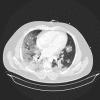Clinical review: primary influenza viral pneumonia
- PMID: 20085663
- PMCID: PMC2811908
- DOI: 10.1186/cc8183
Clinical review: primary influenza viral pneumonia
Abstract
Primary influenza pneumonia has a high mortality rate during pandemics, not only in immunocompromised individuals and patients with underlying comorbid conditions, but also in young healthy adults. Clinicians should maintain a high index of suspicion for this diagnosis in patients presenting with influenza-like symptoms that progress quickly (2 to 5 days) to respiratory distress and extensive pulmonary involvement. The sensitivity of rapid diagnostic techniques in identifying infections with the pandemic 2009 H1N1v influenza strain is currently suboptimal. The most reliable real-time reverse transcriptase-polymerase chain reaction molecular testing is available in limited clinical settings. Despite 6 months of pandemic circulation, most novel H1N1v pandemic strains remain susceptible to oseltamivir. Ensuring an appropriate oxygenation and ventilation strategy, as well as prompt initiation of antiviral therapy, is essential in management.
Figures
References
Publication types
MeSH terms
LinkOut - more resources
Full Text Sources
Other Literature Sources
Medical



